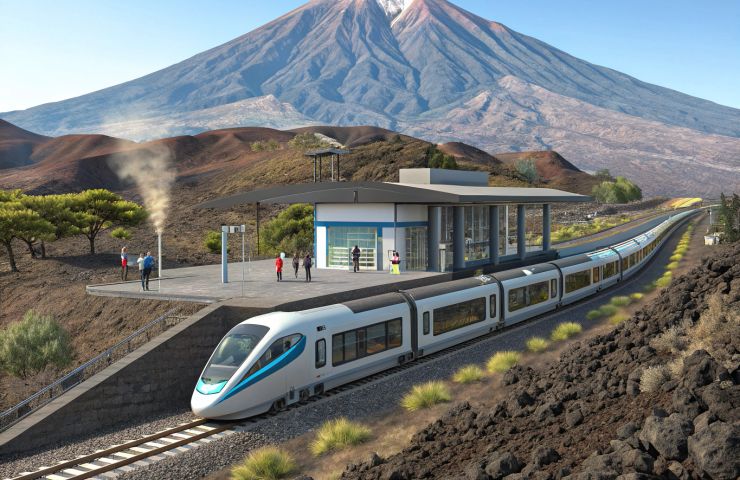
Hydrogen Trains Expand in Sicily with Stadler Rail’s FLIRT H2 Order
October 10, 2025Stadler Rail AG just inked a game-changing deal with Ferrovia Circumetnea (FCE), setting the stage for the first hydrogen trains on Sicily’s narrow-gauge lines hugging Mount Etna. Signed on 03/10/2025, the contract covers two trainsets—each featuring two low-floor coaches flanking a central power pack bristling with hydrogen fuel cells and high-pressure tanks for green hydrogen. Beyond the hardware, Stadler throws in five years of hands-on tech support, spare parts and remote diagnostics, while FCE can expand the hydrogen fleet down the road if demand takes off. Passengers will also notice the whisper-quiet rides—perfect for soaking in Etna’s vistas without the usual diesel racket.
A Fresh Start for Sicily’s Narrow-Gauge Network
Sicily’s 950 mm, non-electrified rails have leaned on diesel shuttles for way too long, rumbling past volcanic slopes, olive groves and citrus orchards. Electrifying this rugged terrain would mean stringing poles and wires where seismic tremors, strong winds and salty sea air can wreak havoc—and costs would skyrocket in remote spots. With hydrogen traction, you sidestep those headaches entirely, turning a tricky decarbonization puzzle into a plug-and-play solution—no overhead wires needed. Each FLIRT H2 train seats 87 passengers (147 at crush capacity) and can run over 500 km on a single fill—just like its cousins elsewhere—so FCE can keep timetables intact with minimal tweaks to current depots. Morning commuters will appreciate the punctual, clean service, while weekend hikers and sightseers can count on reliable connections to trailheads and scenic stops. It’s a prime opportunity to slash diesel use, cut CO₂ emissions and reduce noise pollution in one smooth move.
Under the Hood: Engineering & Design Highlights
The FLIRT H2 platform is a real modular marvel, blending flexibility and cutting-edge hydrogen fuel cell tech. At its core sits a “power pack” housing a proton-exchange membrane stack and four high-pressure tanks feeding green hydrogen into the system to generate electricity for the traction motors. Onboard batteries capture regenerative braking energy, smoothing out power peaks on those steep Etna climbs. Thanks to a low-floor design, hopping aboard with wheelchairs, strollers or bikes is a breeze, and wide gangways keep foot traffic flowing. Inside, passengers enjoy climate control, panoramic windows, LED lighting, on-board Wi-Fi and infotainment—all drawing from the same zero-emission energy source. When it’s time for maintenance, fuel cell stacks, tanks or battery units can be swapped in a matter of hours, cutting downtime and trimming upkeep costs.
What This Means for Regional Decarbonization
This order catapults Sicily to the front of Italy’s green transport wave. Old diesel units pump out nitrogen oxides, particulates and constant rumble that can jar valley communities like Valle dell’Alcantara—more reason to make the switch to clean-running hydrogen trains. And if that hydrogen comes from renewable-powered electrolysis, the climate wins are even bigger. Sicilian authorities are already scouting solar and wind farms to feed green hydrogen plants, while new refuelling stations in Catania and Riposto will sync with train arrivals and departures. Beyond cleaner air, the move sparks a local skills boom—technicians getting up to speed on hydrogen infrastructure installation, safety certification and station management. Sure, upfront capital costs exceed those of diesel fleets, but lifecycle analyses point to lower operational expenses, quieter rides and major environmental payoffs—bolstering Sicily’s standing as a hub for sustainable energy and eco-friendly tourism.
Eyes on Tomorrow: Scaling Up the Fleet
FCE’s flexible option to snag more units under this deal gives regional planners time to gather real-world intel—energy consumption, maintenance intervals, passenger feedback and even noise level data—before going full scale. Meanwhile, Stadler’s factories in Switzerland and the US are ramping up production, with 19 hydrogen trainsets already slated for Italy, which should shave months off lead times for follow-on deliveries. The first two trains will tackle the toughest sections between Catania and Etna’s lower villages, where traction and regenerative braking really earn their stripes. Hit the sweet spot on performance metrics, and FCE could unlock carbon-pricing incentives and tap economies of scale, pushing per-unit costs down toward diesel parity under Italy’s evolving climate regulations.
Meet the Players
Stadler Rail AG, founded in 1942 and based in Bussnang, Switzerland, has built its legacy on modular rolling stock—from trams and metros to high-speed mainline trains. In recent years, they’ve doubled down on zero-emission technology, rolling out battery, hybrid and hydrogen trains across Europe and North America. Ferrovia Circumetnea, in operation since 1895, runs a 110 km narrow-gauge network around Mount Etna, linking Catania, Giarre and Riposto. With this hydrogen-powered venture, FCE is positioning itself as a trailblazer in regional sustainable energy, while helping to build the hydrogen infrastructure that’ll keep these trains humming for decades.
It’s not every day you see zero-emission trains conquering volcanic slopes, but Sicily’s rail riders will soon have that thrill—quietly gliding past Etna’s craters on a steady flow of green hydrogen. By pairing clean power production with advanced hydrogen fuel cells, the partnership between Stadler and FCE is blazing a trail for non-electrified corridors everywhere. Who knows? If this scheme hits its marks, we could see hydrogen trains hitting the rails in other remote or environmentally sensitive regions around the globe.



 With over 15 years of reporting hydrogen news, we are your premier source for the latest updates and insights in hydrogen and renewable energy.
With over 15 years of reporting hydrogen news, we are your premier source for the latest updates and insights in hydrogen and renewable energy.